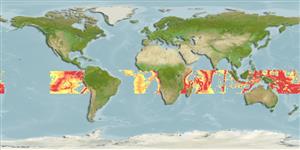>
Aulopiformes (Grinners) >
Ipnopidae (Deep-sea tripod fishes) > Ipnopinae
Etymology: Ipnops: Greek, hypnos = sleep + Greek, ops = appearance (Ref. 45335).
Eponymy: Alexander Emanuel Rodolphe Agassiz (1835–1910) was born in Switzerland but emigrated to the USA with his eminent palaeontologist father, Louis Agassiz (see next entry), and made a fortune out of copper mining. [...] (Ref. 128868), visit book page.
More on author: Garman.
Environment: milieu / climate zone / depth range / distribution range
Écologie
marin bathydémersal; profondeur 1392 - 4163 m (Ref. 3590). Deep-water; 6°N - 22°S
Eastern Atlantic: Mid-Atlantic Ridge at latitudes of 5°- 6°N and off Namibia. Elsewhere, widely scattered localities in the Indo-Pacific.
Taille / Poids / Âge
Maturity: Lm ? range ? - ? cm
Max length : 16.5 cm TL mâle / non sexé; (Ref. 41039); common length : 13.5 cm SL mâle / non sexé; (Ref. 3590)
Description synthétique
Clés d'identification | Morphologie | Morphométrie
Épines dorsales (Total) : 0; Rayons mous dorsaux (Total) : 9 - 11; Épines anales: 0; Rayons mous anaux: 15 - 19. Head black, body dark.
Abyssobenthic on the lower slope and rise. Largest eggs ca 0.8 mm; fecundity is low with ca 85-300 eggs per clutch. Eyes are particularly modified into flat lenseless plaques as in Ipnops murrayi.
Life cycle and mating behavior
Maturité | Reproduction | Frai | Œufs | Fécondité | Larves
Merrett, N.R., 1990. Chlorophthalmidae. p. 351-360. In J.C. Quero, J.C. Hureau, C. Karrer, A. Post and L. Saldanha (eds.) Check-list of the fishes of the eastern tropical Atlantic (CLOFETA). JNICT, Lisbon; SEI, Paris; and UNESCO, Paris. Vol. 1. (Ref. 3590)
Statut dans la liste rouge de l'IUCN (Ref. 130435: Version 2024-1)
Menace pour l'homme
Harmless
Utilisations par l'homme
Pêcheries: sans intérêt
Outils
Articles particuliers
Télécharger en XML
Sources Internet
Estimates based on models
Preferred temperature (Ref.
123201): 1.9 - 3.2, mean 2.3 °C (based on 1066 cells).
Phylogenetic diversity index (Ref.
82804): PD
50 = 0.6250 [Uniqueness, from 0.5 = low to 2.0 = high].
Bayesian length-weight: a=0.00479 (0.00191 - 0.01202), b=3.03 (2.81 - 3.25), in cm total length, based on LWR estimates for this (Sub)family-body shape (Ref.
93245).
Niveau trophique (Ref.
69278): 3.3 ±0.4 se; based on size and trophs of closest relatives
Résilience (Ref.
120179): Milieu, temps minimum de doublement de population : 1,4 à 4,4 années (Preliminary K or Fecundity.).
Fishing Vulnerability (Ref.
59153): Low vulnerability (10 of 100).
